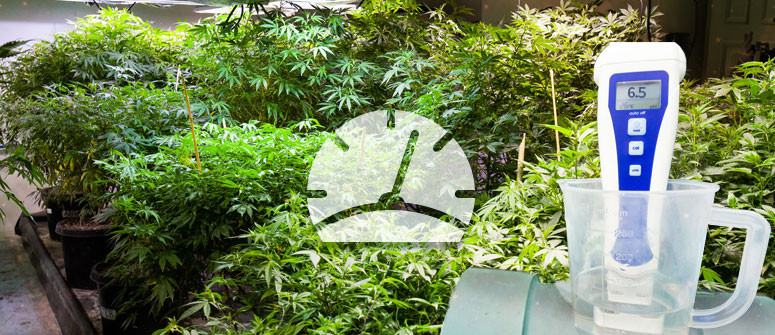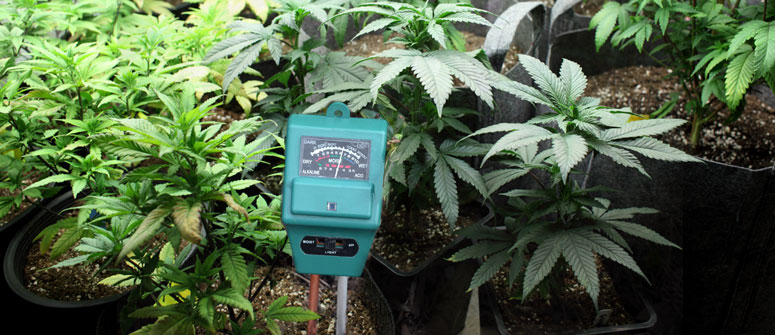How to calibrate your ph meter

Calibrating a pH meter can sound scary, but it's really simple. In this article, we show you exactly how to calibrate your pH meter.
Getting an accurate pH reading of your soil or grow medium is extremely important when growing cannabis. The best way to get an accurate reading of your soil is using a well-calibrated pH meter.
Unfortunately, the thought of calibrating a pH meter can be a little scary, especially for first time growers. Luckily, calibrating your pH meter is simple. Here are some general instructions for calibrating both digital and manual pH meters.
DIGITAL PH PROBES
There are a wide variety of digital pH meters available on the market at different price points. Nonetheless, the steps for calibrating these meters is usually the same, using a few different calibration solutions.
To calibrate your digital pH meter, start by putting on a pair of gloves. Next, pour a small amount of each calibration solution into separate containers. Most pH probes will include a 4 pH, 7 pH, and 10 pH solution. Make sure your probe is clean and always use fresh calibration solutions to ensure the best results.
Next, submerge the probe at the end of your digital meter into the 4 pH solution. Once submerged, press and hold the calibration button on your meter. You may need to hold the button for a few seconds.
Once you’re pen has been calibrated to 4 pH, clean the probe of the pen and calibrate it in the remaining solutions following the same procedure. Always make sure to clean the probe of the meter before submerging it in another solution.
We always recommend calibrating your pH meter to all of the solutions that came with it. While this isn’t entirely necessary, it ensures a more accurate reading, which will save you a lot of potential headaches later on in your grow.
MANUAL PH PROBES

Calibrating manual pH pens is a little different. These pens will usually feature a screw and pH meter on one end of the pen as opposed to a button.
Just like with a digital pen, submerge the probe of the pen into the solution you want to calibrate to. However, instead of just clicking a button, you’ll need to turn the screw on top of the pen till the meter reading matches the pH of the solution.
Again, make sure to use fresh, room temperature solutions and a clean pen. Also calibrate your pH meter to 2 or 3 solutions for more accurate results.
TIPS FOR CALIBRATING YOUR PH METER
The processes for calibrating a pH meter we outlined above are general. The exact process might vary slightly from one model to another. Here are some simple tips to further help you calibrate your pH meter:
ALWAYS READ THE MANUAL
We can’t stress this enough; before trying to calibrate your meter, take the time to read over the user manual. It only takes a few minutes and ensures you don’t miss any crucial steps that might be unique to the model you’re working with.
CALIBRATE YOUR METERS REGULARLY
When it comes to measuring your pH, you want to be pretty accurate. And the best way to do that is to regularly calibrate your meter. As we saw above, calibrating a pH meter is really simple, so try to make it a regular part of your grow room procedure to ensure you get the most accurate readings from your medium every time.
USE THE RIGHT PH BUFFERS
Using the right pH buffers is really essential for accurate readings. pH meters work best when they’ve been calibrated to buffers both above and below the pH you’re hoping to measure.
Hence, if you’re trying to measure a pH of roughly 10, you’ll ideally want to calibrate your meter to 1 buffer below that and another above. This will ensure you get the most accurate reading possible from your meter.
STORE YOUR METER PROPERLY
All products last longer and work better when they’ve been stored properly, and the same goes for pH meters.
In fact, pH meters contain a pH electrode which is very sensitive and, when damaged, can greatly affect the functioning of your meter and the accuracy of its readings.
Hence, always make sure to store your meter as per its instructions, taking extra care to keep your pH electrode out of distilled, reverse osmosis, or deionized water, as this damages the sensing glass.
USE FRESH BUFFERS AND A CLEAN METER
Old or contaminated pH buffers will affect the slope percentage of your reading. Meanwhile, an unclean meter can push the meter’s offset outside its ideal range. We recommend not letting your offset exceed ±30 mV, while working with a slope of roughly 85-105%.
If either of these readings are off, try soaking the probe in cleaning solution. This should adjust any variations in offset. If you’re slope is off, on the other hand, get your hands on new buffers, clean all your equipment, and start the calibration process again.
.jpg)


.jpg)
